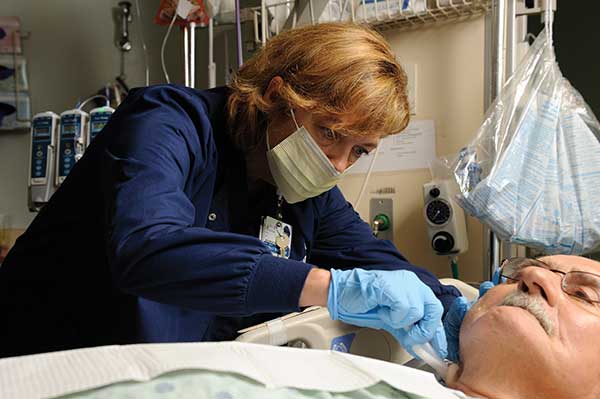Nurse-led multidisciplinary effort decreases central line-associated infections
By Jennifer L.W. Fink, RN, BSN
846 days.
That’s how long the cardiac intensive care unit at Johns Hopkins Bayview Hospital has gone without a central line-associated bloodstream infection.

Two and a half years ago, such a number would have been virtually unthinkable. Central line-associated infections, or CLABSI, were considered an almost unavoidable aspect of care. The cardiac (CICU) and other intensive care units care for patients at high risk of infection anyway, and central lines and CLABSI were thought of as part of the package.
“There was an assumption that we were always going to have central line infections, because of the patients we have,” says Kelly Krout, RN, MSN, interim patient care manager of the surgical intensive care unit and burn intensive care unit.
A highly-effective, nurse-led multidisciplinary effort to decrease CLABSI began by challenging that assumption. “We started with the idea that, ‘Maybe we’re not doing it wrong, but maybe we’re not doing it the best possible way,’” says Kerri Huber, RN, MSN, an infection control specialist who helped coordinate CLABSI-reduction efforts. “We went to each of the intensive care units and said, ‘We really need to work on this. Who should be part of the team?’”
Each unit pulled together a team that included nurse managers, educators, influential staff nurses, laboratory specialists and physicians. The teams reviewed the literature to determine best practices for central line insertion and care, and met regularly to tweak them to the needs of their units. Teams also shared ideas, so when one unit discovered an effective intervention, others could get onboard.
The surgical intensive care unit, for instance, began using a central line insertion checklist created by Hopkins patient safety expert Peter Provonost, MD. “The checklist really gives the nurses the authority to stop a procedure. So if they see the physician who has broken sterility, they can say, ‘Hold on. We’ve deviated from the procedure. We need to stop and regroup,’” Krout says.
The medical intensive care unit and CICU did trials with central line carts, mobile stations that contain all the supplies necessary to insert a central line; the neonatal intensive care unit developed a central line maintenance checklist; and the neurocritical care unit created a daily checklist to monitor central line necessity and care. All of those ideas were so successful that they ultimately spread to the other ICUs.
“This effort was successful because changes were coming from the front line staff,” Huber says. “It wasn’t administrators saying, ‘You have a problem and this is what we’re going to do to fix it.’ It’s bedside nurses putting their heads together and coming up with solutions.”
 JHSON Highlights
JHSON Highlights ‘Helpful, Powerful, Kind’ Palliative Care
‘Helpful, Powerful, Kind’ Palliative Care Heart Health in Native Populations
Heart Health in Native Populations Summer Research Roundup 2023
Summer Research Roundup 2023 DAISY Awards Spring 2023
DAISY Awards Spring 2023







